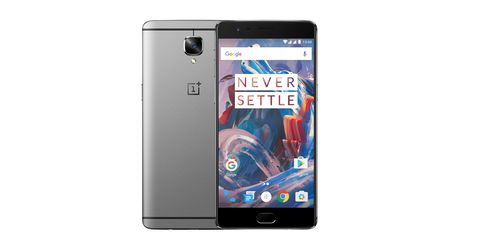IT Pro Verdict
Although let down by a few niggles, this is still a superlative smartphone that shows some of the big household names how it’s done
Pros
- +
Classy looks; Well-made; Bright screen; Fast; Do not disturb switch; Fast and accurate fingerprint reader; Tasteful and useful official cases; Very reasonable price
Cons
- -
Odd screen issues; Not all of the 6GB of RAM is available for use; Merely okay low light photography
Buying an iPhone or a Samsung can be the safe choice (current exploding batteries woes aside), but sometimes seeking out the lesser known entities can mean better value for your hard-earned money.
Rather than going for a knock-off iPhone from a Chinese manufacturer from the depths of eBay, OnePlus shows that this doesn't have to be the case with its surprisingly excellent OnePlus 3 Android phone.
Pricing and casing
Earlier OnePlus phones had cut back on availability in their first few months of life - you could only buy one if you bagged an invite. Although this built up a buzz around the phones, it was a waste of time for anyone who just wanted to buy a phone and then get on with the rest of their lives. These invites are now thankfully a thing of the past - the OnePlus 3 can be ordered now, with orders taking around eight days to fulfil due to high demand at the time of writing.
At 329 inc VAT (it used to be 309 before sterling's Brexit slump pushed up the price), it's easy to see what people are so excited about. While other phones at this price, such as the Nexus 5X and the 4GB Moto G4 Plus, have plastic casings, the OnePlus 3 sports a metal unibody build. Although it highly resembles the Huawei Mate 8, which itself was somewhat derivative of the HTC One M9, this is nonetheless a phone that looks good and feels tough.

It does feel a tad slippery, so we think it's worth spending an extra 16 for OnePlus's own Sandstone' case. Made from an improved version of the material that formed the rear of the OnePlus 2, the coarse, grippy coating of this case makes the OnePlus 3 much easier to hold.
Not only does it feel as if we were less likely to drop this big two-handed 5.5in phablet with the case attached, but it also provided valuable purchase around the edges for our fingers when taking photos and watching video. Although flashier cases made from wood and other more visually attractive materials are available, the Sandstone case is by far our favourite.

Oddly, there's no micro SD slot, but this isn't a critical failing as this phone has 64GB of storage built-in as standard. It should be more than enough when combined with cloud storage. Frequent travellers will appreciate the two nano SIM card slots.
Another welcome extra is the physical Do Not Disturb switch on the left hand side of the phone. It's not quite as simple as the silence/vibrate switch on the iPhone as it's a three way switch that controls Android's Do Not Disturb feature, but it works well enough once you get used to it. Its two alternate modes include priority alerts only and complete silence. More distinctive haptic feedback when using the switch would be a welcome improvement, so you could tell from feel alone which mode you've selected.

Performance and battery life
Performance is usually the first thing that manufacturers skimp on when attempting to make a phone that's cheaper than the flagships, but just as good looking. That's not the case here. Equipped with the latest Qualcomm Snapdragon processor, the quad core 820, it blitzed its way through our benchmarks.
The Snapdragon 820 is paired with a whopping 6GB of RAM. However, at the time of writing memory management on OnePlus' version of Android Marshmallow was still so aggressive at clearing unused apps out of memory that it effectively makes no difference to multitasking performance.
Plus, considering most other high end Android phones only' have 3 or 4GB, most developers won't retool their apps to take advantage of all that RAM. Such a huge amount of memory seems more like a marketing gimmick than a practical benefit at the moment, but it could ensure a significant amount of future proofing if OnePlus ever tweak how their version of Android uses it.
Battery life was astonishingly good. It lasted just under 17 hours in our video playback test, one of the longest scores we've seen. Some other phones fare well in our video test, but fall down in actual day-to-day use. That wasn't the case with the OnePlus 3 - it lasted a lengthy 45 hours when connected to BT Mobile's 4G network in London and used for a mix of everyday tasks except for 3D gaming.

Display and camera
Samsung might have pioneered the use of AMOLED screens on smartphones, but everyone else is in on the game now. The 5.5in AMOLED screen used here is crisp and sharp thanks to its 1080p resolution, while contrast is spot on and brightness is very high. Colours are oversaturated though, so photos and videos look unrealistically vibrant. A fix, in the form of an update to Android's developer options allowing you to switch a more realistic colour scheme, has been promised. There were no problems with the responsiveness of the touchscreen - it was effortlessly smooth and accurate with only very occasional hints of lag.

The 16 megapixel rear camera takes sharp and detailed shots in daylight. Although a few details were lost in areas such as especially brightly lit clouds and landscapes, this was a relatively minor flaw as it didn't happen too often in our shooting.
A bigger problem was photography in low light. Despite the wide f2 aperture and optical image stabilisation, dimly lit shots were just a bit too blurry and full of noise. Shots were at least well exposed and didn't suffer from the ugly smearing from aggressive post-processing that blighted many older Android phones, but ultimately it's not as good as the Nexus 5X or the more expensive Nexus 6P and Galaxy S7.

Oxygen OS and the fingerprint reader
The OnePlus 3 launched running Android 6.0, which introduced a lot of new features to Google's smartphone platform, including a new apps menu for browsing your installed applications, an apps search bar, and new app favourites slots at the top of the screen. Google also introduced a memory manager to Android 6.0 that allows you to track what's consuming the most memory on your handset, while the battery manager allowed you to see which apps were using the most battery.
Now, two years on, OnePlus has confirmed its 2016 device will be getting the upcoming Android P update rather than taking on the incremental Android 8.1 update.
The company said: "After internal discussions and evaluation, we have decided to focus our development resources on the Android P project, instead of upgrading the OnePlus 3 and 3T device to Android 8.1."
Google and OnePlus are now working closely together to deliver the Android P beta to the OnePlus, although the lower-end and older OnePlus 3 will have to wait until the update has arrived on the flagship OnePlus 5 first. This means it's likely to launch at the end of 2018 or the beginning of 2019.
Google's forthcoming Android P update is a significant step up from Android 6.0, introducing a completely new way of navigating. Gone are the three buttons at the bottom of the screen and instead arrive gestures to open and switch between apps.
There's also usage management features, helping you understand how long you've spent using your phone, adaptive battery, and screen brightness that learn your habits and adjust the battery life and screen brightness at certain times of the day. This works in a similar way to App Actions, which again uses machine learning to understand what needs to be done when, according to your habits.
Android 6.0 Marshmallow has OnePlus' own interface overlay on top which it calls OxygenOS. It's little different from stock Android at first glance, but Google Now has been evicted from its usual resting place to the left of the first home screen. In it's place is a shelf filled with your most frequently used apps and contacts as well as a note taking widget. It might be useful to some, but we quickly banished it with the Google Now Launcher.
More useful are a series of lock screen gestures such as drawing an O with your finger to launch the camera, swiping with two fingers to skip music tracks or drawing a V to turn on the flashlight. You can turn these off if you wish.
Another feature that can be disabled is the strip of physical touch sensitive Android buttons sitting below the screen. Turning them off enables the now-familiar on-screen Android button bar. We prefer this arrangement as it frees up the bottom bezel to act as a grip for our fingers when grappling with this unwieldy phablet, even if that does mean that the fingerprint reader no longer acts as a home button which feels odd.
The fingerprint scanner itself worked quickly and reliably, with only occasional false negatives. It also effectively doubles as a second wake button - tapping it with our registered finger was enough to unlock the phone in the blink of an eye.
Conclusions
The OnePlus 3 is an astonishingly good value phone that almost blows the similarly priced competition out of the water. The only things holding it back are the odd limitations around its 6GB of RAM and oversaturated screen as well as its merely so-so low light photography. These quirks and problems are enough to prevent the OnePlus 3 from getting an unconditional recommendation, but if you can live with them then this is still a remarkable phablet.
Verdict
Although let down by a few niggles, this is still a superlative smartphone that shows some of the big household names how it’s done
| Processor | Quad-core 2.2GHz Qualcomm Snapdragon 820 |
| Screen size | 5.5in |
| Screen resolution | 1,920x1,080 |
| Rear camera | 16 megapixels |
| Storage (free) | 64GB (52.6GB) |
| Wireless data | 3G, 4G |
| Size | 153x75x7.3mm |
| Weight | 158g |
| Operating system | OxygenOS (Android 6.0.1) |
| Warranty | One year RTB |
| Details | www.oneplus.net |
| Part code | A3003 |


